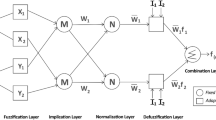Abstract
In the present work, water absorption of lightweight geopolymers produced by fine fly ash and rice husk–bark ash together with palm oil clinker (POC) aggregates has been investigated experimentally and modeled by adaptive network-based fuzzy inference systems (ANFIS). Different specimens made from a mixture of fine fly ash and rice husk–bark ash with and without POC were subjected to water absorption tests at 2, 7, and 28 days of curing. The specimens were oven cured for 36 h at 80 °C and then cured at room temperature until 2, 7, and 28 days. The results showed that high amount of POC particles improve the percentage of water absorption at the early age of curing. In addition, the ratio of “the percentage of water absorption” to “weight” of the POC-contained specimens at all ages of curing was much higher than that of POC-free specimens, which make them suitable for lightweight applications. To build the model, training, validating, and testing using experimental results from 144 specimens were conducted. The used data in the ANFIS models are arranged in a format of six input parameters that cover the quantity of fine POC particles, the quantity of coarse POC particles, the quantity of FA + RHBA mixture, the ratio of alkali activator to ashes mixture, the age of curing, and the test trial number. According to these input parameters, the water absorption of each specimen was predicted. The training, validating, and testing results in the ANFIS models showed a strong potential for predicting the water absorption of the geopolymer specimens.







Similar content being viewed by others
Change history
15 June 2020
The Editor-in-Chief has retracted this article [1] because it significantly overlaps with a number of articles including those that were consideration at the same time [2] and previously published articles [3���6]. Additionally, the article shows evidence of peer review manipulation. The authors have not responded to any correspondence regarding this retraction.
References
Wongpa J, Kiattikomol K, Jaturapitakkul C, Chindaprasirt P (2010) Compressive strength, modulus of elasticity, and water permeability of inorganic polymer concrete. Mater Des 31:4748–4754
Lloyd RR, Provis JL, van Deventer JSJ (2009) Microscopy and microanalysis of inorganic polymer cements. 1: remnant fly ash particles. J Mater Sci 44:608–619
Kumar S, Kumar R, Mehrotra SP (2010) Influence of granulated blast furnace slag on the reaction, structure and properties of fly ash based geopolymer. J Mater Sci 45:607–615
Álvarez-Ayuso E, Querol X, Plan F, Alastuey A, Moreno N, Izquierdo M, Font O, Moreno T, Diez S, Vázquez E, Barra M (2008) Environmental, physical and structural characterisation of geopolymer matrixes synthesised from coal (co-)combustion fly ashes. J Hazard Mater 154:175–183
Sata V, Jaturapitakkul C, Kiattikomol K (2007) Influence of pozzolan from various byproduct materials on mechanical properties of high-strength concrete. Constr Build Mater 21(7):1589–1598
Tangchirapat W, Buranasing R, Jaturapitakkul C, Chindaprasirt P (2008) Influence of rice husk–bark ash on mechanical properties of concrete containing high amount of recycled aggregates. Constr Build Mater 22(8):1812–1819
Nazari A, Bagheri A, Riahi S (2011) Properties of geopolymer with seeded fly ash and rice husk bark ash. Mater Sci Eng A 528:7395–7401
Mohammed BS, Al-Ganad MA, Abdullahi M (2011) Analytical and experimental studies on composite slabs utilising palm oil, clinker concrete. Constr Build Mater 25:3550–3560
Nazari A, Didehvar N (2011) Modeling impact resistance of aluminum-epoxy laminated composites by ANFIS. doi:10.1016/j.compositesb.2011.05.043
Jang JSR (1993) ANFIS: adaptive-network-based fuzzy inference system. IEEE Trans Syst Man Cybern 23(3):665–685
Sarıdemir M (2009) Predicting the compressive strength of mortars containing metakaolin by artificial neural networks and fuzzy logic. Adv Eng Soft 40(9):920–927
Pacheco-Togal F, Castro-Gomes J, Jalali S (2007) Investigation about the effect of aggregates on strength and microstructure of geopolymeric mine waste mud binders. Cem Concr Res 37(6):933–941
Pacheco-Torgal F, Castro-Gomes JP, Jalali S (2005) Studies about mix composition of alkali-activated mortars using waste mud from Panasqueira. In: Proceedings of the engineering conference. University of Beira Interior, Covilha, Portugal
Bakharev T (2005) Geopolymeric materials prepared using Class F fly ash and elevated temperature curing. Cem Concr Res 35:1224–1232
Chindaprasirt P, Chareerat T, Sirivivatnanon V (2007) Workability and strength of coarse high calcium fly ash geopolymer. Cem Concr Compos 29:224–229
ASTM C642 (2001) Standard test method for density, absorption, and voids in hardened concrete. ASTM, Philadelphia, PA
Naji Givi A, Abdul Rashid S, Nora A, Aziz F, Mohd Salleh MA (2010) Assessment of the effects of rice husk ash particle size on strength, water permeability and workability of binary blended concrete. Constr Build Mater 24(11):2145–2150
Ramezanianpour AA, Sobhani M, Sobhani J (2004) Application of network based neuro-fuzzy system for prediction of the strength of high strength concrete. Amirkabir J Sci Technol 5(59-C):78–93
Ramezanianpour AA, Sobhani J, Sobhani M (2004) Application of an adaptive neurofuzzy system in the prediction of HPC compressive strength. In: Proceedings of the fourth international conference on engineering computational technology. Civil-Comp Press, Lisbon, Portugal, p 138
Topcu IB, Sarıdemir M (2008) Prediction of mechanical properties of recycled aggregate concretes containing silica fume using artificial neural networks and fuzzy logic. Comput Mater Sci 42(1):74–82
Jang JSR, Sun CT (1995) Nuro-fuzzy modeling and control. Proc IEEE 83(3):378–406
Guzelbey IH, Cevik A, Erklig A (2006) Prediction of web crippling strength of cold-formed steel sheetings using neural networks. J Constr Steel Res 62:962–973
Topcu IB, Sarıdemir M (2008) Prediction of compressive strength of concrete containing fly ash using artificial neural network and fuzzy logic. Comp Mater Sci 41(3):305–311
Author information
Authors and Affiliations
Corresponding author
Additional information
The Editor-in-Chief has retracted this article because it significantly overlaps with a number of articles including those that were consideration at the same time and previously published articles. Additionally, the article shows evidence of peer review manipulation. The authors have not responded to any correspondence regarding this retraction.
About this article
Cite this article
Nazari, A. RETRACTED ARTICLE: Utilizing ANFIS for prediction water absorption of lightweight geopolymers produced from waste materials. Neural Comput & Applic 23, 417–427 (2013). https://doi.org/10.1007/s00521-012-0934-1
Received:
Accepted:
Published:
Issue Date:
DOI: https://doi.org/10.1007/s00521-012-0934-1




